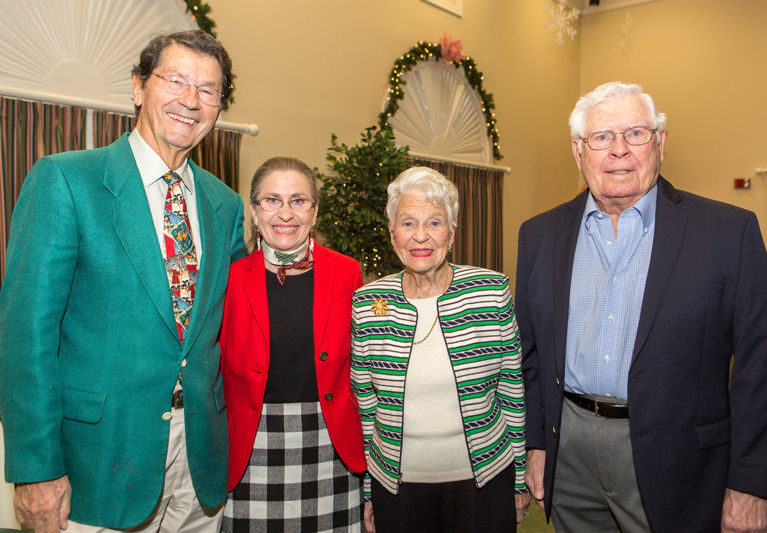
It’s a sure bet that every parent has at some point heard a child of theirs exclaim with excitement, “Guess what I found!”
But few discoveries could ever match that of archaeologist Sharon Stocker, Ph.D., University of Cincinnati senior research associate and the daughter of Oak Harbor residents Nancy and Bob Stocker. During a visit to her parents last week, Stocker graciously offered to share the story of her extraordinary find with residents and guests at a very special Oak Harbor Speaker Series presentation.
“It is such good fortune to have a speaker of this caliber. Young people get into these wonderful careers and it expands our whole lives,” said Jim Balog in his introduction of Stocker, who proceeded to captivate her audience, relating a tale as exciting as any Indiana Jones adventure.
For the past 25 years, Stocker and husband Jack Davis, Ph.D., UC’s Carl W. Blegen Chair in Greek Archeology, have worked on digs around the ancient city of Pylos on the southwest coast of Greece. This past spring, while co-leading a 45-member team of researchers and archaeologists, they unearthed the fully intact Bronze Age tomb of a wealthy warrior, circa 1,500 B.C.
Giving a little historical background, Stocker explained that the tomb predates the nearby Palace of Nestor by an estimated 200 to 300 years. Built during the Mycenaean civilization, the palace had been destroyed by fire circa 1,200 B.C., about the time of the Trojan War memorialized by Homer.
The Stocker/Davis team, hoping to learn more about the lives of palace workers and ordinary citizens, had chosen to dig in a plot of land outside the palace complex and found what they initially thought were the walls of a house or room. Even after realizing that it was a grave, they assumed it would have been looted.
Instead, they made an incredibly rare discovery of riches – the remarkable grave had lain undisturbed for 3,500 years and was abundantly filled with more than 1,400 artifacts.
“That’s really the irony,” said Stocker. “If you go looking for treasure you’ll never find it.”
Even more significant, the ancient treasure and skeletal remains discovered in the shaft grave, a burial custom found on the island of Crete, may provide clues to the transference of power from the culturally advanced Minoans of Crete to the mainland Greek Mycenaean population.
Through their meticulous excavation, fully documented every step of the way, they learned that their warrior had been laid out with care. His ivory and gold-hilted sword and a gold-hilted dagger were placed at his left side. A wealth of jewels lay to his right – four exquisite gold rings with Minoan carvings, including those of Cretan bull jumpers, 50 Minoan seal stones – the most ever found in a mainland grave – beads of precious stones and gold, and a very rare type of gold box-chain necklace, not previously found in that time, with two pendants attached.
Among other items were also numerous silver, bronze and gold vessels, a bronze mirror and ivory combs, and, placed between his legs, an ivory plaque with the carving of a mythical griffin.
“For safety, we made a decision early on to not mention that we had found anything but bronze for the length of the evacuation,” said Stocker, explaining that looting by organized groups is rampant in Greece. The first mention of their full discovery was that of an Oct. 26 New York Times article about the dig. “It’s very dangerous. We consider ourselves lucky that we did not have that problem.”
Stocker explained that dating the grave was difficult due to a lack of pottery. She added with a smile, “It’s very unusual for an archeologist to say, I wish we had ceramics.”
They do not yet know the cause of death for the warrior, who is estimated to be between 30 and 35 years old, but they plan to do DNA analysis in an effort to learn more about him.
The team hopes that the artifacts, currently stored in Kalamata, will remain in a museum in Hora, the same archeological area as the Palace of Nestor. However, Stocker expects that other towns including the modern city of Pylos will likely lay claim to it.
“The conservation is going to take years. We feel an obligation to keep it safe. It keeps me awake,” said Stocker, who goes by the site daily and has noticed that the unexpected discovery has resulted in some added benefits for the people of Greece.
“The effect it had in Greece was that it raised a type of patriotism in a way we didn’t expect to happen. It’s a happy story in a hard time; people are genuinely proud. This has the potential to attract tourism, which is what is really needed. The potential impact is huge.”



